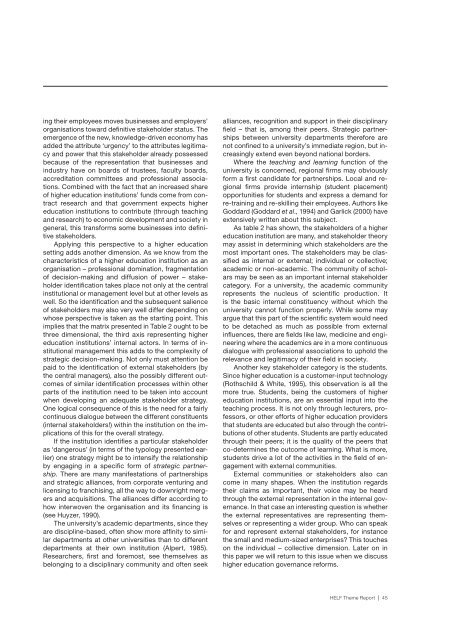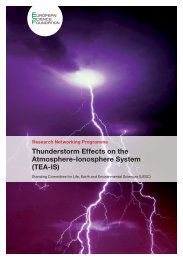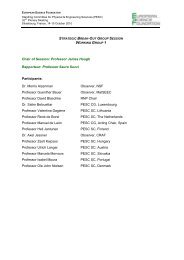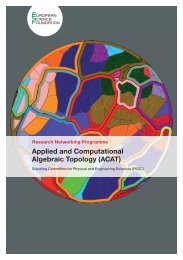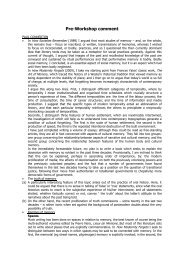Report - European Science Foundation
Report - European Science Foundation
Report - European Science Foundation
You also want an ePaper? Increase the reach of your titles
YUMPU automatically turns print PDFs into web optimized ePapers that Google loves.
ing their employees moves businesses and employers’<br />
organisations toward definitive stakeholder status. The<br />
emergence of the new, knowledge-driven economy has<br />
added the attribute ‘urgency’ to the attributes legitimacy<br />
and power that this stakeholder already possessed<br />
because of the representation that businesses and<br />
industry have on boards of trustees, faculty boards,<br />
accreditation committees and professional associations.<br />
Combined with the fact that an increased share<br />
of higher education institutions’ funds come from contract<br />
research and that government expects higher<br />
education institutions to contribute (through teaching<br />
and research) to economic development and society in<br />
general, this transforms some businesses into definitive<br />
stakeholders.<br />
Applying this perspective to a higher education<br />
setting adds another dimension. As we know from the<br />
characteristics of a higher education institution as an<br />
organisation – professional domination, fragmentation<br />
of decision-making and diffusion of power – stakeholder<br />
identification takes place not only at the central<br />
institutional or management level but at other levels as<br />
well. So the identification and the subsequent salience<br />
of stakeholders may also very well differ depending on<br />
whose perspective is taken as the starting point. This<br />
implies that the matrix presented in Table 2 ought to be<br />
three dimensional, the third axis representing higher<br />
education institutions’ internal actors. In terms of institutional<br />
management this adds to the complexity of<br />
strategic decision-making. Not only must attention be<br />
paid to the identification of external stakeholders (by<br />
the central managers), also the possibly different outcomes<br />
of similar identification processes within other<br />
parts of the institution need to be taken into account<br />
when developing an adequate stakeholder strategy.<br />
One logical consequence of this is the need for a fairly<br />
continuous dialogue between the different constituents<br />
(internal stakeholders!) within the institution on the implications<br />
of this for the overall strategy.<br />
If the institution identifies a particular stakeholder<br />
as ‘dangerous’ (in terms of the typology presented earlier)<br />
one strategy might be to intensify the relationship<br />
by engaging in a specific form of strategic partnership.<br />
There are many manifestations of partnerships<br />
and strategic alliances, from corporate venturing and<br />
licensing to franchising, all the way to downright mergers<br />
and acquisitions. The alliances differ according to<br />
how interwoven the organisation and its fi nancing is<br />
(see Huyzer, 1990).<br />
The university’s academic departments, since they<br />
are discipline-based, often show more affinity to similar<br />
departments at other universities than to different<br />
departments at their own institution (Alpert, 1985).<br />
Researchers, first and foremost, see themselves as<br />
belonging to a disciplinary community and often seek<br />
alliances, recognition and support in their disciplinary<br />
field – that is, among their peers. Strategic partnerships<br />
between university departments therefore are<br />
not confined to a university’s immediate region, but increasingly<br />
extend even beyond national borders.<br />
Where the teaching and learning function of the<br />
university is concerned, regional firms may obviously<br />
form a first candidate for partnerships. Local and regional<br />
firms provide internship (student placement)<br />
opportunities for students and express a demand for<br />
re-training and re-skilling their employees. Authors like<br />
Goddard (Goddard et al., 1994) and Garlick (2000) have<br />
extensively written about this subject.<br />
As table 2 has shown, the stakeholders of a higher<br />
education institution are many, and stakeholder theory<br />
may assist in determining which stakeholders are the<br />
most important ones. The stakeholders may be classified<br />
as internal or external; individual or collective;<br />
academic or non-academic. The community of scholars<br />
may be seen as an important internal stakeholder<br />
category. For a university, the academic community<br />
represents the nucleus of scientific production. It<br />
is the basic internal constituency without which the<br />
university cannot function properly. While some may<br />
argue that this part of the scientifi c system would need<br />
to be detached as much as possible from external<br />
influences, there are fields like law, medicine and engineering<br />
where the academics are in a more continuous<br />
dialogue with professional associations to uphold the<br />
relevance and legitimacy of their fi eld in society.<br />
Another key stakeholder category is the students.<br />
Since higher education is a customer-input technology<br />
(Rothschild & White, 1995), this observation is all the<br />
more true. Students, being the customers of higher<br />
education institutions, are an essential input into the<br />
teaching process. It is not only through lecturers, professors,<br />
or other efforts of higher education providers<br />
that students are educated but also through the contributions<br />
of other students. Students are partly educated<br />
through their peers; it is the quality of the peers that<br />
co-determines the outcome of learning. What is more,<br />
students drive a lot of the activities in the field of engagement<br />
with external communities.<br />
External communities or stakeholders also can<br />
come in many shapes. When the institution regards<br />
their claims as important, their voice may be heard<br />
through the external representation in the internal governance.<br />
In that case an interesting question is whether<br />
the external representatives are representing themselves<br />
or representing a wider group. Who can speak<br />
for and represent external stakeholders, for instance<br />
the small and medium-sized enterprises? This touches<br />
on the individual – collective dimension. Later on in<br />
this paper we will return to this issue when we discuss<br />
higher education governance reforms.<br />
HELF Theme <strong>Report</strong> | 45


